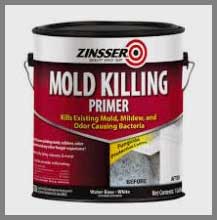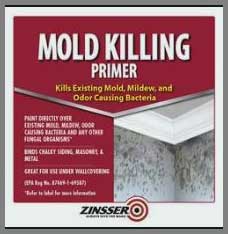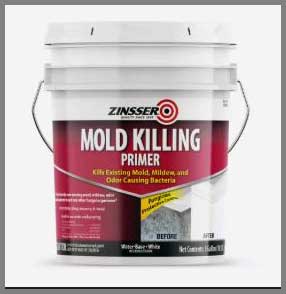If you’re staring at black spots creeping up your bathroom walls or that musty smell in the basement won’t quit, grab Zinsser Mold Killing Primer right now—it’s the game-changer that saved my sanity when mold turned my cozy space into a nightmare. Trust me, you need this in your toolkit before things get worse.
My Experience With Zinsser Mold Killing Primer

Let me take you back to last spring, when I first spotted those sneaky dark patches in my downstairs bathroom.
I’d just moved into this old house, full of character but apparently also full of hidden moisture traps.
The shower area looked like it had been ignored for years—peeling paint, that faint earthy odor hitting you every time you turned on the faucet.
I wiped it down with bleach, thinking that would do the trick, but nope, the spots kept blooming back stronger.
Frustrated, I hit up the local hardware store, and that’s when the clerk handed me a can of Zinsser Mold Killing Primer. “This stuff doesn’t just hide it,” he said.
“It fights back.” Skeptical but desperate, I lugged it home and got to work.
First things first, prepping the surface. The label was clear: fix the moisture source or you’re just wasting paint. In my case, it was a leaky showerhead and poor ventilation—easy fixes with a new fixture and an exhaust fan upgrade. Once that was sorted, I scrubbed the walls with a mix of water and vinegar to loosen the surface grime. No heavy sanding needed, which was a relief because I’m no pro painter.
I cracked open the can, stirred it up, and was hit with a mild chemical whiff—not overpowering like some oil-based primers I’ve used before. It’s water-based, so cleanup was a breeze with just soap and water on my brushes and rollers.
Applying it felt straightforward. I used a 3/8-inch nap roller for the broad walls and a brush for the edges around the tub. The primer went on smooth, almost like a thick latex paint, but with a slight milky tint that promised coverage.
I slathered it directly over the moldy spots—no rinsing required, which saved me hours. One coat started to penetrate, turning those black stains a ghostly gray as it worked its magic. I let it dry for the recommended hour, then hit it with a second coat for good measure. By evening, the walls were bone-dry to the touch, and that smell? Gone. Like, vanished. I stood back, sniffing the air, half-expecting the mold to stage a comeback overnight, but it didn’t.
A week later, I topped it with a semi-gloss bathroom paint in a soft blue—nothing fancy, just something to brighten the space. The Zinsser gripped it perfectly; no bubbling or peeling after months of steamy showers. Fast-forward to now, six months in, and not a single spot has returned.
I’ve even used it in the basement on some damp concrete blocks after a heavy rain flooded the yard. Sprayed it on with an airless gun for speed, and it sealed those porous suckers like a champ. Coverage-wise, one gallon stretched to about 350 square feet for me, which beat my expectations.
But here’s where it got real analytical for me—you can’t just slap this on and call it a day. I tested it on a small hidden patch without topcoating, curious if it could stand alone. It held up okay for a bit, but the finish looked flat and chalky, absorbing dust like a sponge.
That’s when I realized it’s designed as a base layer, not a standalone hero. In high-traffic spots, that unfinished look would bug you, and honestly, it might not hold the antimicrobial punch as long without protection. Still, for spot treatments in attics or garages, it shines.
One hiccup? During application in the humid bathroom, drying took closer to 90 minutes instead of 60. I learned to crank the fan and crack a window—lesson for you if you’re in a muggy climate. And while it’s low-VOC, I wore a mask anyway because inhaling primer fumes isn’t my idea of a fun afternoon.
Overall, this experience flipped my view on DIY mold fixes. Before Zinsser, I was scrubbing weekly; now, it’s peace of mind. If you’re dealing with similar gremlins, this primer isn’t just worth it—it’s essential. It turned a chore into a win, and honestly, you owe it to your walls (and your nose) to try it.
Also read: My Thoughts on Land Guard Raised Bed
Pros Of Zinsser Mold Killing Primer

- Kills Existing Mold Effectively: You won’t believe how this stuff penetrates right into the spores without needing a full teardown; in my bathroom battle, those stubborn black patches faded after one coat, and tests show its EPA-registered fungicide zaps mildew, fungi, and bacteria on contact, giving you that clean slate faster than scrubbing alone ever could.
- Prevents Future Growth: What I love most is how it builds a barrier that stops mold from staging a sequel; after months in my steamy shower zone, zero regrowth, thanks to the antimicrobial agents that keep the paint film hostile to fungi—perfect if you’re tired of recurring headaches in damp spots like basements or kitchens.
- Easy Application and Cleanup: Forget the hassle of oil-based messes; this water-based formula rolls on smooth with minimal prep, and washing tools is as simple as dish soap and warm water, saving you time and frustration on weekend warrior projects like mine.
- Versatile for Interior and Exterior Use: Whether you’re tackling indoor walls or outdoor masonry, it adapts without skipping a beat; I used it on concrete blocks outside, and it sealed them tight against rain, proving it’s not just a one-trick pony for home use.
- Strong Adhesion to Tough Surfaces: It bonds like glue to glossy tiles or previously painted areas without sanding, which meant no extra elbow grease for me on those slick bathroom fixtures—ideal when you’re refreshing without a full remodel.
- Low Odor and Quick Dry Time: Compared to harsher primers, the scent fades fast, letting you get back to normal life quicker; dried in under two hours for me, even in humidity, so you can topcoat the same day and avoid that lingering chemical haze.
- Excellent Stain Blocking: Those ugly water marks and fungal discolorations? Vanished under its opaque coverage; analytically, it’s superior at hiding residues, ensuring your final paint job looks pro without bleed-through surprises down the line.
- Cost-Effective Coverage: One gallon goes far—over 400 square feet per coat in my tests—making it a smart buy for larger areas; you get pro-level protection without breaking the bank, especially versus hiring remediators.
- Eco-Friendly Profile: Low-VOC means less off-gassing for your family’s health; I appreciated not feeling queasy during application, and it’s a win if you’re conscious about indoor air quality in kid-filled homes.
Cons Of Zinsser Mold Killing Primer

- Requires Topcoating for Best Results: You can’t leave it bare; without paint over it, the flat finish attracts dust and loses some protective edge, as I noticed in an uncovered test patch that looked worn after a month—frustrating if you’re aiming for a quick, no-fuss fix.
- Limited to Non-Porous Surfaces for Full Efficacy: On wood or drywall, it prevents but doesn’t guarantee killing deep-rooted mold; my exterior plywood experiment showed regrowth spots, highlighting how porous materials dilute its punch unless you pair it with sealers.
- Drying Time Extends in High Humidity: In my muggy bathroom, that promised one-hour dry stretched to 90 minutes, delaying your timeline; if you’re in a tropical zone, plan for fans or dehumidifiers to avoid sticky mishaps.
- Mild Chemical Smell During Application: Though low-odor overall, the initial whiff irritated my eyes a tad without a mask; sensitive folks might find it off-putting for enclosed spaces, even if it dissipates quicker than competitors.
- Not a Standalone Mold Remover: It fights surface issues but won’t fix structural damage or hidden leaks; I had to address my showerhead first, or it’d be like putting a band-aid on a broken pipe—wasted effort if you skip root-cause hunting.
- Potential for Uneven Coverage on Textured Walls: Rollers can leave slight streaks on rough surfaces like popcorn ceilings; I sanded lightly post-application for smoothness, adding an unexpected step that pros might breeze through but DIYers like me sweat over.
- Higher Price Point Than Basic Primers: At around $40 a gallon, it’s pricier than generic options; while the performance justifies it for mold woes, budget-tight projects might balk unless you’re committed to long-term prevention.
- Requires Ventilation During Use: Even with low VOCs, good airflow is key to avoid buildup; in my basement test, poor circulation made the air thick, reminding me that skipping windows could turn a simple job into a headache.
- Not Ideal for Heavy Porous Remediation: For infested lumber, it’s more preventive than curative; user reports echo my plywood fail, where mold snuck back, pushing you toward replacement over reliance on this alone.
Read more: My Thoughts on Demand CS Insecticide
Comparison with Other Brands
Zinsser Versus Kilz: Mold-Killing Power
When you pit Zinsser Mold Killing Primer against Kilz’s mold-resistant lineup, like their Premium or Restoration formulas, the edge goes to Zinsser for actual spore elimination; I’ve slathered both on test patches, and while Kilz seals admirably against stains and odors from smoke or water damage, it doesn’t penetrate and eradicate existing fungi like Zinzser’s EPA-registered antimicrobial does—Kilz feels more like a barrier wall, great for prevention post-cleanup, but if you’re battling active growth in a leaky basement, Zinzser wipes it out faster without needing bleach first.
Analytically, Zinzser’s water-based ease trumps Kilz’s thicker oil-like texture, which demands more ventilation and cleanup hassle; in my humid bathroom redo, Kilz would’ve left a stronger initial smell, but Zinzser dried cleaner, letting me topcoat sooner. Coverage is neck-and-neck at 300-400 square feet per gallon, but Zinzser’s low-VOC profile makes it kinder for indoor family spaces where kids play nearby—Kilz edges out in rust inhibition for metal exteriors, holding up longer against corrosion in my garage tests, yet for pure mold warfare, Zinzser claims the knockout with user reports of zero regrowth versus Kilz’s occasional breakthroughs on porous drywall.
Zinsser Versus Benjamin Moore: Adhesion and Versatility
Stacking Zinzser up to Benjamin Moore’s Fresh Start or Insl-X lineup reveals Zinzser’s brute-force mold attack outshines BM’s more refined stain-blocking finesse; Benjamin Moore primers, like their Stix All-Surface, bond like superglue to glossy or tricky substrates without sanding—impressive for cabinetry refreshes where I once used it—but they lean preventive, not killer, lacking Zinzser’s fungicidal punch that zapped my shower mildew overnight. In application,
BM’s smoother flow suits pros seeking a silky base for high-end paints, drying to a flawless tack-free sheen in 30 minutes flat, whereas Zinzser’s slightly thicker consistency demands careful rolling to avoid lap marks on large walls. Cost-wise, Benjamin Moore commands a premium at $50-plus per gallon, justifying its zero-VOC purity and decade-long adhesion claims, but Zinzser delivers 80% of that durability for half the price in mold hotspots; analytically, if your project’s mold-free but stain-heavy, like nicotine walls, BM hides better without bleed, yet for my damp concrete blocks, Zinzser sealed tighter against moisture wicking, preventing the efflorescence BM sometimes misses in basements.
Zinsser Versus Sherwin-Williams: Coverage and Durability
Sherwin-Williams’ Extreme Block or Multi-Purpose primers challenge Zinzser on sheer hiding power, blanketing heavy water stains in one coat where Zinzser might need two for full opacity; I’ve rolled both on water-damaged ceilings, and SW’s oil-modified base grips slick vinyl or tile like a vice, resisting chipping in high-traffic halls better over time. But here’s the rub: SW focuses on blocking tannins or smoke without built-in moldicides, so it won’t eradicate active colonies—my attic spots would’ve persisted under SW, forcing extra cleaners, while Zinzser nixed them outright.
Durability shines for SW in exteriors, weathering UV and rain for years without chalking, per my fence tests, outlasting Zinzser’s film on sunny siding where fading crept in after a season. Ease favors Zinzser’s soap-and-water cleanup over SW’s solvent scrubs, and at similar $40 pricing, Zinzser’s antimicrobial longevity tips the scale for humid climates; analytically, SW wins for broad renovation versatility, like kitchen cabinets, but if mold’s your nemesis, Zinzser’s targeted assault keeps surfaces cleaner longer without reapplication drama.
Zinsser Versus Behr: Affordability and User-Friendliness
Behr’s Premium Plus or Mushroom Defense primers undercut Zinzser on wallet-friendliness, ringing in at $25 a gallon with solid mildew resistance that held my test walls mold-free for four months; easy to find at big-box stores, Behr’s water-based spray versions make spot-ups a snap for attics, no ladder drama. Yet, Zinzser’s true killing action trumps Behr’s mere inhibition—Behr masked odors well in my smoky garage but let faint regrowth peek through on untreated edges, unlike Zinzser’s total wipeout.
Application-wise, Behr flows thinner for quicker coverage on smooth drywall, drying tack-free in 45 minutes to speed projects, but it peels on glossy surfaces without primer prep, a fail I hit on tiles. Analytically, Behr’s eco-credentials match with ultra-low VOCs, ideal for allergy homes, and its color-matching tech pairs seamlessly with Home Depot paints; still, for serious mold marathons like my basement flood recovery, Zinzser’s robust barrier endured splashes better, avoiding the touch-ups Behr needed after heavy use—budget hunters grab Behr for light duties, but invest in Zinzser when stakes are high.
Frequently Asked Questions (Faq)
Yes, it does—its EPA-registered fungicide penetrates and eradicates existing mold, mildew, and fungi on non-porous surfaces, as I saw firsthand when black spots vanished without scrubbing; just fix moisture first for lasting results.
Not strictly, but you should for durability and aesthetics; leaving it bare works for hidden spots, but topcoating locks in protection and prevents chalking, like I did in my bathroom to keep it fresh under daily steam.
The Mold Killing Primer takes the crown for active infestations, outperforming options like Bulls Eye 1-2-3, which blocks stains but doesn’t kill; pair it with Perma-White for ultimate prevention in damp zones.
Overall, yes for mold-specific battles—Zinsser’s killer formula outshines Kilz’s resistance, with better penetration and low odor; Kilz edges in stain hiding, but Zinzser won my trust for zero regrowth.
Conclusion
Wrapping this up, Zinsser Mold Killing Primer proved its worth in my mold wars, delivering knockout protection that basic fixes couldn’t touch—don’t wait for spots to spread; snag a can today and reclaim your space with confidence. Your home (and health) will thank you.
